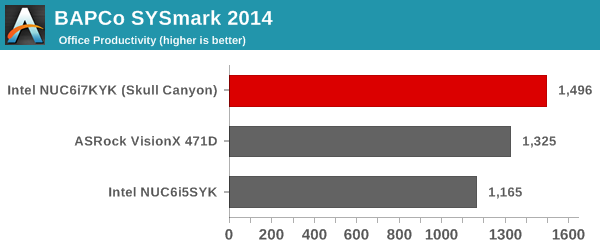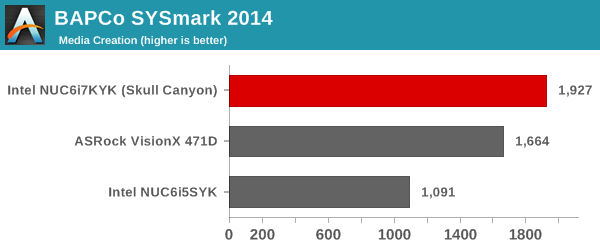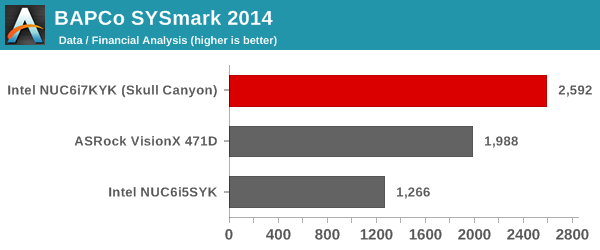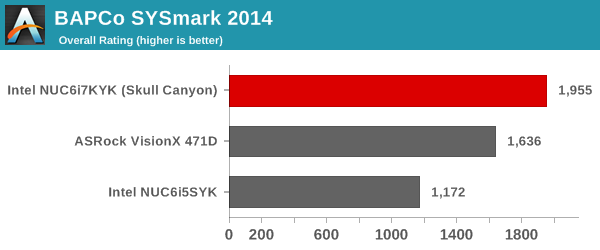The Intel Skull Canyon NUC6i7KYK mini-PC Review
by Ganesh T S on May 23, 2016 8:00 AM ESTPerformance Metrics - I
The Intel NUC6i7KYK (Skull Canyon) was evaluated using our standard test suite for low power desktops / industrial PCs. Not all benchmarks were processed on all the machines due to updates in our testing procedures. Therefore, the list of PCs in each graph might not be the same. In the first section, we will be looking at SYSmark 2014, as well as some of the Futuremark benchmarks.
BAPCo SYSmark 2014
BAPCo's SYSmark 2014 is an application-based benchmark that uses real-world applications to replay usage patterns of business users in the areas of office productivity, media creation and data/financial analysis. Scores are meant to be compared against a reference desktop (HP ProDesk 600 G1 with a Core i3-4130, 4GB RAM and a 500GB hard drive) that scores 1000 in each of the scenarios. A score of, say, 2000, would imply that the system under test is twice as fast as the reference system.




We started using SYSmark 2014 quite recently, which is the main reason for the absence of many of the comparison systems in the above graphs. In any case, the most interesting of the compared lot when it comes to CPU-intensive benchmarks like SYSmark 2014 is the ASRock VisionX 471D, equipped with a Core i7-4712MQ processor. We can see that the Core i7-6770HQ-based Skull Canyon NUC6i7KYK is miles ahead of the other two systems when it comes to office / business workloads. Readers interested in comparing the SYSmark 2014 scores for systems based on other CPUs can peruse the Bench results here.
Futuremark PCMark 8
PCMark 8 provides various usage scenarios (home, creative and work) and offers ways to benchmark both baseline (CPU-only) as well as OpenCL accelerated (CPU + GPU) performance. We benchmarked select PCs for the OpenCL accelerated performance in all three usage scenarios. These scores are heavily influenced by the CPU in the system. As expected, the Core i7-6770HQ enables the NUC6i7KYK to easily come out on top in the charts.



Miscellaneous Futuremark Benchmarks

The graphics benchmarks present a different story, though. In these, the NUC6i7KYK does perform well enough to come in the top half. However, in scenarios which are not CPU-bound, the systems equipped with discrete GPUs easily turn out to be better than Skull Canyon.




3D Rendering - CINEBENCH R15
CINEBENCH R15 is a standard benchmark for 3D rendering. It provides three benchmark modes - OpenGL, single threaded and multi-threaded. Evaluation of select PCs in all three modes provided us the following results.



In the single-threaded case, the Core i7-4770R (a 65W TDP CPU which can turbo up to 3.9 GHz) performs slightly better than the Core i7-6770HQ. However, the latter wins out in the multi-threaded cases. In the OpenGL case, the GIGABYTE system with the discrete GPU wins out, showing that a combination of CPU power as well as GPU is needed to perform well in this benchmark.










133 Comments
View All Comments
FlyingAarvark - Monday, May 23, 2016 - link
All of the Skull Canyon reviews so far online have been relative failures. I hate to bash this work but a few points that need to be said.To only test this with 2133Mhz is a shame. Intel stated that 2400Mhz works without a FSB OC and you can run up to 3000Mhz with one. That would change the gaming performance tremendously but not a single site has bothered testing this.
We just didn't learn anything that wasn't easily known from just looking at this on Newegg. We knew it would be really fast for the size/power requirements. We knew it would be fairly hot on-load due to past NUCs. But we didn't know how it would react with DDR4 2400/2800/3000+.
The other problem is that there's concern expressed in the review that bidirectional 4GB/sec bandwidth isn't enough. Its been proven and known if you look into it that PCIE 1.0 x16 (4GB/sec) does not bottleneck a GTX 980. Skull Canyon should be closer to 5GB/sec than 4GB as well. This wasn't tested with a Razer Core, but I think there's a really good change this is the fastest stock gaming CPU on the market today when paired with a discrete GPU due to the 128MB L4. It was shown that Broadwell 5775Cs were already holding that crown in the past.
Considering how incredibly impressive this NUC is already with its small size, low power draw, various Thunderbolt3 options (storage/GPU/docks): both of these points on faster DDR4 and 128MB L4 impact with a dGPU would make it even more impressive than it already is and probably result in slam dunk territory.
I think everyone in the tech community is massively missing the mark on this one! It just hasn't been properly tested. Intel absolutely nailed this product but is failing to properly instruct reviewers on what to test. Send me a sample, forumemail123 at g mail. I'll do it right.
jardows2 - Monday, May 23, 2016 - link
So, you want this product reviewed in tests that will show it in a better light, and ignore all the standard tests that give it an apples-to-apples comparison, showing that Intel has a long ways to go to provide good value to their customers in this market segment?FlyingAarvark - Monday, May 23, 2016 - link
Ah an AMD poverty gamer arrives. Apples to apples against what? Older NUCs? There is no other competition for this small of a form factor. Certainly not from AMDone.I'm asking that the things that all of us who have been so excited about this product have wanted to see. DDR4-3000 IGP gaming performance and Razer Core FuryX or 980Ti performance.
As I noted, this review told me absolutely nothing that wasn't already known just through common sense. No one will buy this thing for a ho-hum NUC, there's already plenty of those. We're buying them for the size/performance combo and going to run 3000Mhz DDR4 or Razer Core with it.
JoeyJoJo123 - Monday, May 23, 2016 - link
Nobody said anything about AMD, dude.jardows2 - Tuesday, May 24, 2016 - link
You just showed your true colors. I am anything but an "AMD poverty gamer." I need to know how this device compares to other computing devices, so I can determine if the small form factor benefit is worth the performance hit. Very few people are going to have a demand for a computer that fits a particular small form factor, and are willing to do anything to hit that size requirement. Most people just want the best value, and size is a component to that.If we are performing tests that show best case scenario for this unit, then we'd have to do the same for every other bare-bones unit. Then there would be no true comparison, and each piece would be no better than a cnet review bought and paid for by the manufacturer, and we would be no better informed.
FlyingAarvark - Tuesday, May 24, 2016 - link
Nice attempt at digging yourself out of that hole: you'd be pissed to see this thing shown in a positive light because as you said supposedly, "Intel has a long ways to go to provide good value". Shows how much you know, just taking the typical fanboy stance on this thing without knowing what you're even looking at- much like this review.The point remains: people want to see this used with varying RAM speeds. It affects the gaming performance greatly due to the IGP. Also people want to see it benched with a 980Ti / 1080 to compare to other high end gaming CPUs.
There's absolutely no reason that's "best case" at all. It's just asking for a full review.
stux - Monday, May 23, 2016 - link
I'm curious if the BIOS supports RAID0/1 and if so, what the performance from dual sm950s in RAID0 is.Sounds like that'd be bumping up against the DMI bottleneck.
revanchrist - Monday, May 23, 2016 - link
Very dissapointed TBH. i7 5775C performs on par with a GTX 750, so i thought this 6770HQ packed with a much stronger integrated graphics and double the eDRAM will be a monster but instead it performed much weaker, can't even matched a 5675C let alone a 5775C. I guess the power limit and TDP really limit the potential of the iGPU. Sigh. Probably need to wait until 7nm CPU to have a playable 1080p integrated graphics solution.spikebike - Tuesday, May 24, 2016 - link
Maybe the drivers haven't caught up. Or maybe it's heavily throttled because of heat. Seems very strange that it's not a substantial upgrade from the 5675c or 5775c. Hopefully, something else with a similar form factor will ship with the same CPU. Note the very wide difference between the two gtx 960 based units in this review.ganeshts - Tuesday, May 24, 2016 - link
This is a 45W TDP part, while the 5775C is a 65W TDP part. That is a substantial difference, as a larger TDP allows more leeway for the GPU than just the 20W difference would suggest.Also, not sure why multiple commentators are talking about two GTX 960 / same GPU when it comes to the GB-BXi5G-760 and the MAGNUS EN970. They are not the same GPU at all - the former uses the Kepler GK104-based 870M, while the latter uses the Maxwell GM104-based 970M.